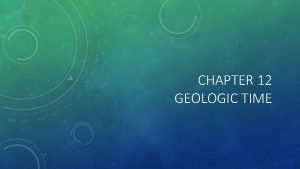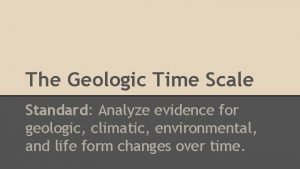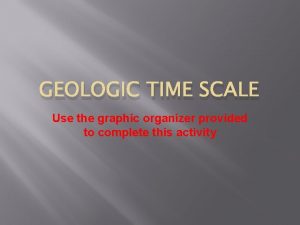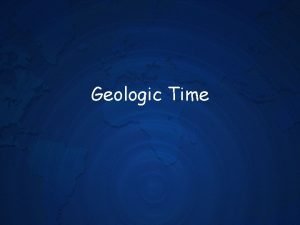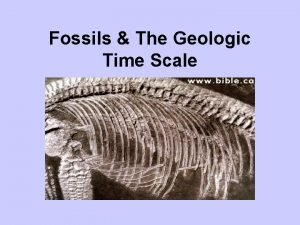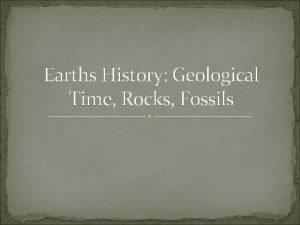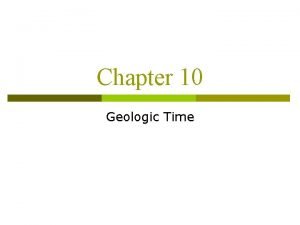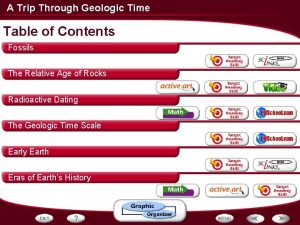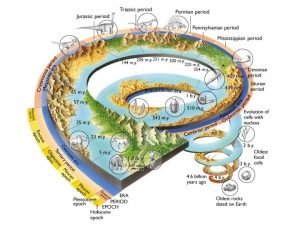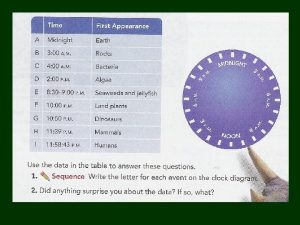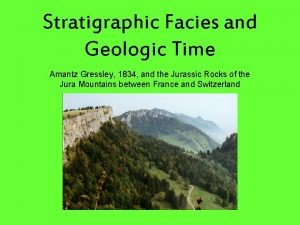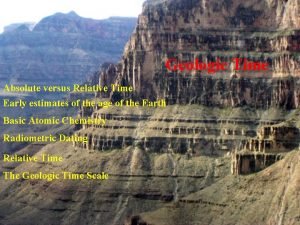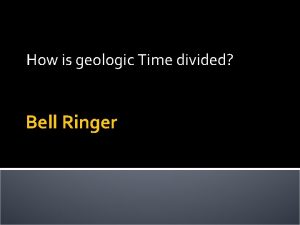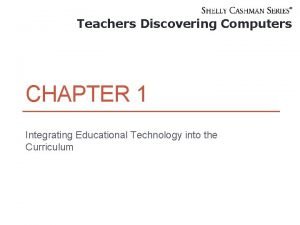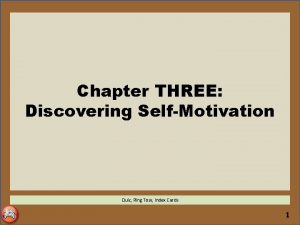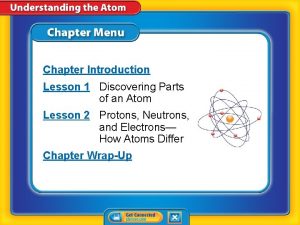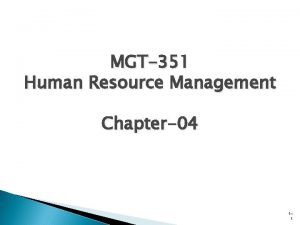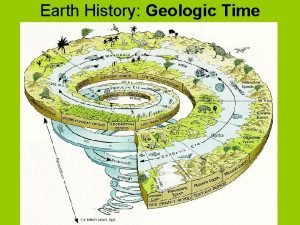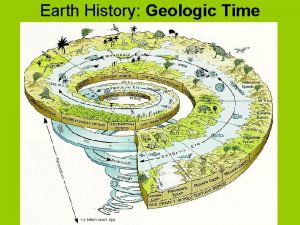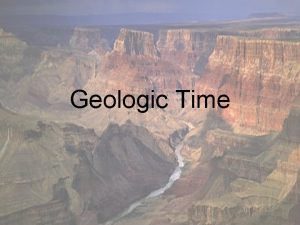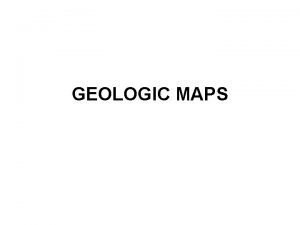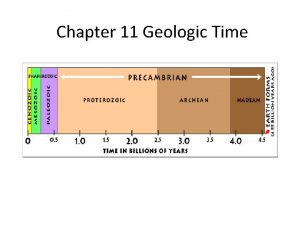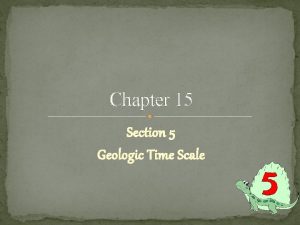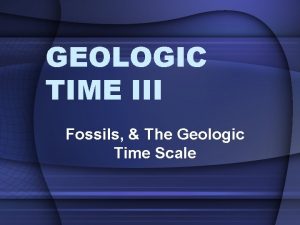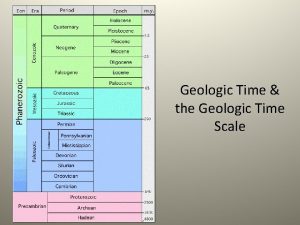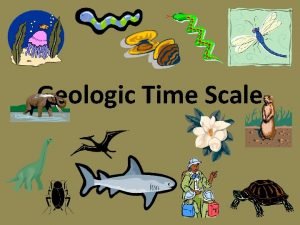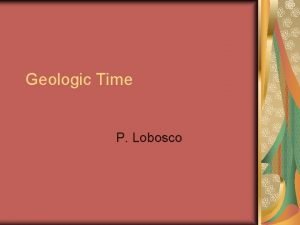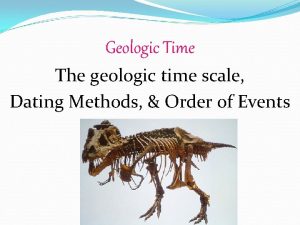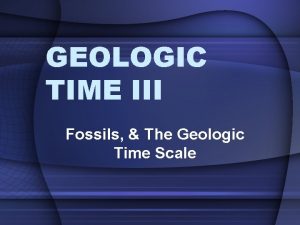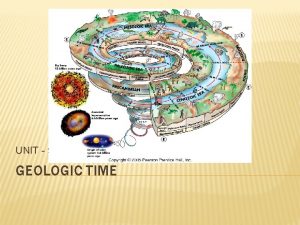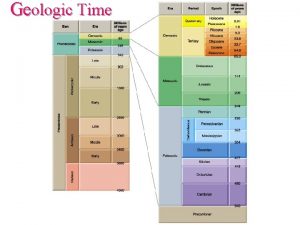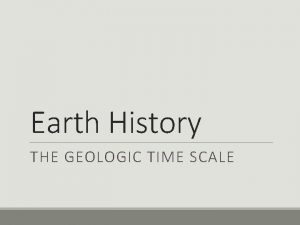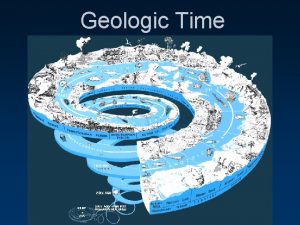CHAPTER 12 GEOLOGIC TIME SECTION 12 1 DISCOVERING
























- Slides: 24

CHAPTER 12 GEOLOGIC TIME

SECTION 12. 1 DISCOVERING EARTH’S HISTORY • Uniformitarianism – the idea that physical, chemical, and biological laws that operate today also operated in the past; the present is the key to the past. • James Hutton’s work was the basis for the science of geology. He was a Scottish physician and farmer in the 1700 s. He is known as the father of geology.

STENO’S THE LAW OF SUPERPOSITION • Relative Dating – simply tells you which rock layers formed first, second, third, etc. It does not give you an exact age. • Law of Superposition – in an undisturbed sequence of sedimentary rock, each layer is older than the one above it and younger than the one below it. (Oldest are on the bottom and the youngest on top. )

GEOLOGIC PRINCIPLES • Steno’s Principle of Original Horizontality – sediment is deposited in flat, horizontal layers. • Principle of Cross-Cutting Relationships – a fault or intrusion must by younger than the geologic formation through which it cuts.

UNCONFORMITIES – A BREAK IN THE ROCK RECORD • Angular Unconformity – layers of sedimentary rock form over older layers that are tilted and folded.

UNCONFORMITIES – A BREAK IN THE ROCK RECORD • Disconformity – two sedimentary rock layers are separated by an erosional surface.

UNCONFORMITIES – A BREAK IN THE ROCK RECORD • Nonconformity – an erosional surface separates older metamorphic or igneous rocks from younger sedimentary rocks.

CORRELATION • Correlation – the process of matching rocks layers at different locations that formed at the same time and by the same processes. • Scientists correlate rock layers at different locations to piece together a more complete interpretation of the rock record. • Scientists must sometimes rely on fossils to complete the correlation.

CORRELATION

SECTION 12. 2 FOSSILS: EVIDENCE OF PAST LIFE • Extinct – all members of a species have died on Earth. • Fossil – the preserved remains or traces of an organism. • There are many different types of fossils which include petrified fossils, molds and casts, compressions, impressions, unaltered remains, and trace fossils.

TYPES OF FOSSILS • Petrified Fossils – organic remains are replaced by minerals over a long period of time. • Molds – when a shell or hard part of an organism gets buried in sediment and decays leaving an empty cavity behind in the rock which details the outside of the structure. • Casts – when the empty cavity of a mold fills with mud or minerals and hardens.

TYPES OF FOSSILS • Compression Fossils – 2 D organic remains. Thin film of carbon left behind by an organism. • Impression Fossils – 2 D fossils that do not contain organic matter. They show fine details of the external structure of the organism. • Unaltered remains – when parts or whole organisms are frozen, trapped in tar seeps, or trapped in amber (tree sap). • Trace fossils – footprints, burrows, coprolites (fossilized dinosaur dung), and gastroliths (polished stomach stones of dinosaurs).

COMPRESSION FOSSILS

IMPRESSION FOSSILS

UNALTERED REMAINS

TRACE FOSSILS

THE FOSSIL RECORD • All the fossils found, arranged by their relative ages, make up the fossil record. • Two conditions that favor preservation of a fossil – rapid burial and hard parts. • Fossil succession – fossil organisms tend to found in the same general order at different locations on Earth. • Index fossils – fossil that was geographically widespread and abundant in the fossil record, but existed for only a limited span of time. • Fossils can help build detailed pictures of past environments.

FOSSILS AND EVOLUTION • Fossils provide evidence of evolution. • Evolution – change in organisms over time. • Darwin’s Natural Selection – traits that improve an individual’s chance of survival and reproduction will be passed on more frequently to future generations than traits that do not. (“survival of the fittest”) • Adaptations – beneficial traits

SECTION 12. 3 DATING WITH RADIOACTIVITY • Radioactivity – unstable atomic nuclei spontaneously break apart, or decay, releasing energy. • Radioactive isotopes – elements with more neutrons than normal. They will decay from their parent isotopes into daughter products until stability is reached. Uranium 238 decays over millions of years until it eventually turns into Lead 206. • Half Life – the amount of time necessary for one half of the nuclei in a sample of radioactive isotope to decay to its stable isotope.

RADIOMETRIC DATING • Method of calculating the absolute age, or exact age, of rocks and minerals that contain certain radioactive isotopes. • Scientists measure the ratio between the radioactive parent isotope and the daughter products in a sample to be dated. The older the sample, the more daughter product it contains. • Radiometric Dating of rocks and minerals now have the age of the Earth to be at least 4. 6 billion years old.

DATING WITH CARBON-14 • Carbon-14 is used to date organic materials in a method called radiocarbon dating. • When an organism dies, the amount of carbon-14 gradually decreases as the carbon-14 decays. By comparing the ratio of carbon-14 to carbon-12 in a sample, radiocarbon dates can be determined.

SECTION 12. 4: THE GEOLOGIC TIME SCALE • Geologic time scale – a record that includes both geologic events and major developments in the evolution of life. • Eons represent the longest intervals of geologic time. Eons are divided into eras. Each era is subdivided into periods. Finally, periods are divided into still smaller units called epochs. • We live in the Phanerozoic Eon, Cenozoic Era, Quaternary Period, and Holocene Epoch.

THE GEOLOGIC TIME SCALE • Eons - there are 4 total. 88 percent of geologic time is made up of the 1 st three eons ( Hadean, Archean, Proterozoic), which are all included in Precambrian time. The Phanerozoic is the current eon. • Precambrian time – the Earth formed, the atmosphere and oceans developed, and early life evolved. • Eras – there are 3 eras within the Phanerozoic eon (Paleozoic, Mesozoic, and Cenozoic)

THE GEOLOGIC TIME SCALE • Periods – characterized by geologic events, environmental conditions, and life forms. • Epochs – a smaller unit of a period. The Cenozoic Era is divided into periods and epochs due to the abundant fossil record of the recent past.
 Compare geologic time with the geologic column.
Compare geologic time with the geologic column. Chapter 12 geologic time
Chapter 12 geologic time How is the geologic time scale organized
How is the geologic time scale organized Geological time scale graphic organizer
Geological time scale graphic organizer Geologic time calendar
Geologic time calendar Geologic time scale animals
Geologic time scale animals Fossils
Fossils Geologic time scale drawing
Geologic time scale drawing Geologic time
Geologic time Largest division of geologic time
Largest division of geologic time Geologic time scale drawing
Geologic time scale drawing Nooa
Nooa Time scale
Time scale Facies
Facies Silurian period
Silurian period Geologic time scale
Geologic time scale What is the longest subdivision in geologic time
What is the longest subdivision in geologic time 4 zoic eras
4 zoic eras Discovering computers 2018 chapter 1 ppt
Discovering computers 2018 chapter 1 ppt Discovering computers 2018 chapter 1
Discovering computers 2018 chapter 1 In the formula v x e = motivation
In the formula v x e = motivation Discovering computer
Discovering computer Chapter 7 lesson 1 discovering parts of an atom answer key
Chapter 7 lesson 1 discovering parts of an atom answer key Job analysis in hrm
Job analysis in hrm Discovering the humanities 4th edition
Discovering the humanities 4th edition

